
|
Astronomy Picture Of the Day (APOD)
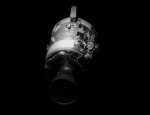 Damage to Apollo 13
Damage to Apollo 13
17.04.2010
After an oxygen tank exploded and crippled their service module, the Apollo 13 astronauts were forced to abandon plans to make the third manned lunar landing. The extent of the damage is revealed...
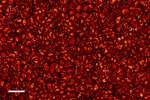 Bright Points on the Quiet Sun
Bright Points on the Quiet Sun
16.04.2010
Up close, the solar surface is a striking patch work of granules in this very high resolution picture of the quiet Sun. Caused by convection, the granules are hot, rising columns of plasma edged by dark lanes of cooler, descending plasma.
 NGC 4651: The Umbrella Galaxy
NGC 4651: The Umbrella Galaxy
15.04.2010
Spiral galaxy NGC 4651 is a mere 35 million light-years distant, toward the well-groomed constellation Coma Berenices. About 50 thousand light-years across, this galaxy is seen to have a faint umbrella-shaped structure (right) that seems to extend some 50 thousand light-years farther, beyond the bright galactic disk.
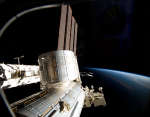 A Large Space Station Over Earth
A Large Space Station Over Earth
14.04.2010
The International Space Station is the largest object ever constructed by humans in space. The station perimeter now extends over roughly the area of a football field, although only a small fraction of this is composed of modules habitable by humans.
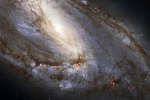 Unusual Spiral Galaxy M66 from Hubble
Unusual Spiral Galaxy M66 from Hubble
13.04.2010
Why isn't spiral galaxy M66 symmetric? Usually density waves of gas, dust, and newly formed stars circle a spiral galaxy's center and create a nearly symmetric galaxy. The differences between...
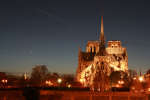 Mercury and Venus Over Paris
Mercury and Venus Over Paris
12.04.2010
Go outside tonight and see one of the more interesting planetary conjunctions of recent years. Just after sunset, the planets Mercury and Venus are visible quite near each other. Now Venus, being commonly discernible as one of the brightest objects in the sky, is frequently mistaken for an airplane.
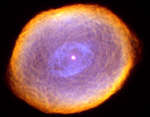 IC 418: The Spirograph Nebula
IC 418: The Spirograph Nebula
11.04.2010
What is creating the strange texture of IC 418? Dubbed the Spirograph Nebula for its resemblance to drawings from a cyclical drawing tool, planetary nebula IC 418 shows patterns that are not well understood. Perhaps they are related to chaotic winds from the variable central star, which changes brightness unpredictably in just a few hours.
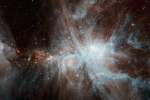 Spitzer s Orion
Spitzer s Orion
10.04.2010
Few cosmic vistas excite the imagination like the Orion Nebula, an immense stellar nursery some 1,500 light-years away. Spanning about 40 light-years across the region, this new infrared image from the Spitzer Space...
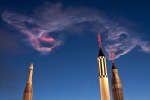 Discovery s Dawn
Discovery s Dawn
9.04.2010
On April 5, visitors to Kennedy Space Center saw these colorful clouds, twisting and drifting through dawn skies. Of course, the clouds were rocket engine plumes from the predawn launch of the space shuttle Discovery on the STS-131 mission to the International Space Station.
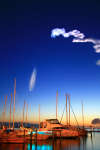 Discovery s Cloud
Discovery s Cloud
8.04.2010
The space shuttle orbiter Discovery is now docked with the International Space Station, some 350 kilometers above planet Earth. Last Monday, its launch to orbit was a beautiful one as it rose into clear, predawn skies at 6:21am EDT from Kennedy Space Center's pad 39A.
|
January February March April May June July August September October November December |
|||||||||||||||||||||||||||||||||||||||||||||||||